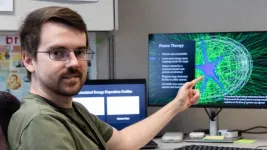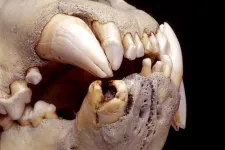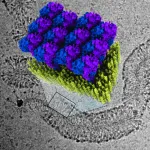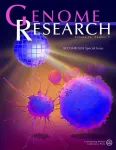BRIC scientists plan to evaluate the ability of accelerator-based proton therapy, like that offered locally by HUPCI, to replace treatments using radioactive sources, such as cobalt-60, to reduce potential radiological risks that could be associated with such isotopes.
Helming the study is Cameron Clarke, a Jefferson Lab staff scientist who developed the proposal in conjunction with colleagues Michael Dion and Eric Christy.
“As an early-career scientist who has just joined the lab as a staff member working explicitly to further the BRIC initiative, I am very excited to have received this green light from the DOE,” Clarke said. “I am also excited about how the genesis of this project reflects the effectiveness of the labwide collaborative approach that BRIC is aiming to facilitate, and I can’t wait to continue to pursue those connections as I dive into the study.”
Scientists in BRIC collaborate with private- and public-sector partners to assist with the development of new devices and systems which apply the lab’s knowledge of, and decades of world-class expertise with, particle accelerators and detectors.
Among Jefferson Lab's BRIC-related innovations are advanced nuclear medicine imaging devices to better detect cancer; using electron beams for water treatment; and developing radiation imaging detectors for plant biology research to help find ways to optimize plant productivity, biofuel development and carbon sequestration in biomass.
Pros and cons
The new study is funded by the DOE National Nuclear Security Administration’s Office of Radiological Security (ORS) and will run through fiscal year 2025. ORS focuses on global radiological security and promotes alternative technologies to reduce the use of radioactive source-based devices as a form of permanent risk reduction.
External beam radiotherapy is the use of external radiation to pass through the body and deposit energy to internal organs. It can be done using X-rays, gamma rays or subatomic particles such as electrons, neutrons or protons.
Proton therapy is the use of an external proton beam, much like the one at the DOE Office of Science user facility at Jefferson Lab, the Continuous Electron Beam Accelerator Facility, which is used to study the building blocks of matter using an electron beam.
Each method has its pros and cons.
Proton therapy, for instance, is difficult and expensive to implement, requiring a hospital or clinic to build a particle accelerator, radiation shielding and large rotating gantries to enable multiple angles of treatment.
Radiotherapy using radioisotope sources, meanwhile, needs only a clinical room-size apparatus to house the hot source and shielding and collimators to focus the beam used in treatment.
But the key advantages of proton therapy are the engineered safety features that prevent the radiation source from causing radiological hazards, which come from localizing most of the energy deposition and enabling rapid radiation source powering on and off. The spatial localization is especially attractive for treatment of cancerous tumors near sensitive tissues, such as for prostate and brain cancers, as well as for pediatric care, and the engineered radiation source control is attractive for radiological safety concerns.
Clarke and his colleagues will survey current state-of-the-art technologies and practical barriers to replacing radioisotope-based radiotherapy in collaboration with HUPCI and other clinical sites. They will also procure a proton therapy-capable computer treatment planning system and simulate the relative cancer treatment performance capabilities to use in discussions with medical practitioners and help bridge the gap between nuclear physics researchers and medical treatment professionals.
“Tangible positive impacts”
Initially interested in astronomy, Clarke grew intrigued with nuclear physics while an undergraduate at Mississippi State University when his professors, who worked in Jefferson Lab’s Hall C on the Q-weak experiment and others, shared their research experience in a fundamental physics class.
He was ultimately won over when he participated in DOE’s Science Undergraduate Laboratory Internships program at Jefferson Lab in 2014 and had a hands-on introduction to detectors, nuclear physics and imaging.
Clarke earned his bachelor’s in physics in 2015, then his doctorate in experimental nuclear and particle physics from the State University of New York at Stony Brook on Long Island in 2021.
While at SUNY, he returned to Jefferson Lab to help run the PREX-II experiment in 2019 and the CREX experiment in 2020.
“During the pandemic, while working in isolation, I started exploring career trajectories that could build off of my technical background while generating more immediately tangible positive impacts on people around me,” Clarke said. “This led me to be interested in industry research applying detector physics to medical imaging.”
In 2021, he began a stint as a detector scientist with Canon Medical Research USA, Inc., working on next-generation semiconductor-based detectors for photon counting computed tomography scanners before returning to Jefferson Lab as a staff scientist.
“I am excited to work at Jefferson Lab, because I get to come to work every day and learn something new about how nuclear physics principles and technologies can be applied to improve the lives of myself and everyone around me,” Clarke said.
“A key aspect of my journey as a scientist has been curiosity — asking questions to understand how the world and everything in it works and learning how to use the tools of science to find the answers in collaboration with world-class experts and colleagues.
“My journey from nuclear physics to industry medical imaging and now back to a sort of middle point between the two was the result of seeking areas of research that balance my competing desires to ask basic questions and to make immediately impactful technological developments that help people in their daily lives.”
Further Reading
Jefferson Lab Establishes Biomedical Research & Innovation Center
Highlights of the BRIC Unveiling Event
From the Early Universe, to Protons, to Cancer Therapy
By Tamara Dietrich
-end-
Jefferson Science Associates, LLC, manages and operates the Thomas Jefferson National Accelerator Facility, or Jefferson Lab, for the U.S. Department of Energy's Office of Science.
DOE’s Office of Science is the single largest supporter of basic research in the physical sciences in the United States and is working to address some of the most pressing challenges of our time. For more information, visit https://energy.gov/science.
END




